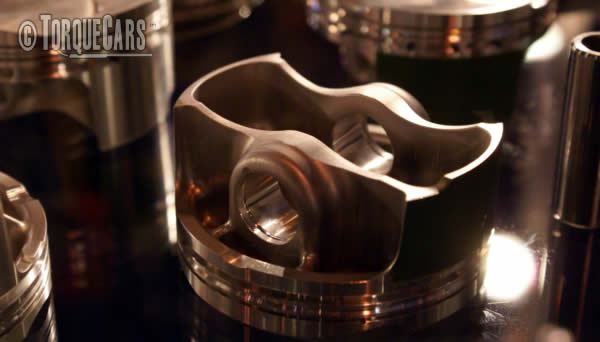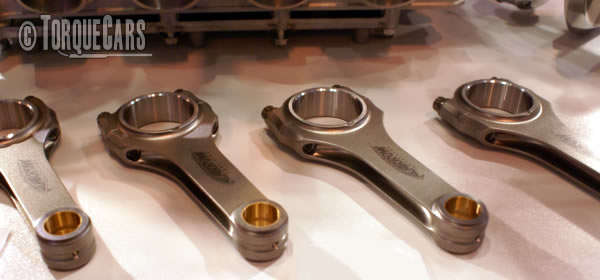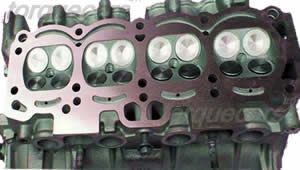Lowering the compression ratio
"Reducing your compression ratio?"
What is the compression ratio?
It's the amount of air that an engine can squish ready for the bang phase of combustion.
For example A 10:1 compression ratio simply means that 10 units of air will be compressed into the space of just 1 unit.
The compression ratio (CR) plays a big part in how well an engine performs.
The problem of knock, (where the air fuel mix prematurely ignites) is controlled to a large degree by the compression ratio. See our video on our YouTube channel to learn more about knock and detonation.
NB you can use a higher octane fuel to reduce issues with knock, another option could be using water injection, but the real engineered solution is simply to reduce the compression ratio.
Best ways of lowering an engine compression ratio.
While you are reducing the compression ratio it would make sense to strengthen the internal engine parts.
This makes even more sense if you using forced induction to increase the power of your engine.
5 good ways to reduce your compression ratio
- Low compression pistons. This seems to be the way to go. The pistons are much shorter than conventional ones, thereby decreasing the stroke. A small plus is that they are also often lighter so the engine will rev a little more freely.
We would recommend combining low compression pistons with a shorter stroke to get the most benefit. The shape of the piston crown will also have a bearing on the amount of compression that takes place in the engine.
This will require a strip down of the engine and whilst the engine is apart you may just as well perform some of the other mods listed below.
- Reboring the engine. Increasing the cylinder capacity can potentially lower the compression ratio, but this very much depends on the stroke, rods and pistons selected. In most cases a rebore will increase the compression ratio of your engine.
- Shorter rods, revised shorter stroke crank = lower compression. Anything that makes the combustion chamber larger will lower the compression ratio if the pistons travel a shorter distance and do less "compressing". Therefore a crankshaft with reduced stroke is what you need to reduce the compression ratio when combined with lower compression pistons as you are typically working to the same deck height.
A shorter stroke will have a dramatic effect on the compression ratio and is the route to go if you are adding a turbo. By combining this method with low compression pistons one can start to think about running very high boost pressures when adding a turbo.
The crank will also have some impact on the throw of the engine and the crank, piston crowns and rods should ideally all be matched up.
Interestingly changing rod length will not affect the cylinder capacity, this is set by the bore and piston area. Shorter rods will accelerate faster and requires careful adjustments in the valve timing.

- Head work, again increases the volume of the cylinder but the effectiveness depends a lot on how the intake and exhaust valves are sited, and how much space there is for you to work with.
Removing the head is relatively simple and does not require as much effort as other compression lowering mods.
However, it requires great skill to do a proper job on the head and achieve the lower compression ratio you are seeking. Replacing the head with a different profile one can also reduce the compression ratio slightly.
- Thicker head gaskets. This option is a bit of a bodge, but we should mention it as a lot of people do run thicker gaskets to achieve a lower compression ratio.
We have also seen people using 2 gaskets (or more) to achieve a lower compression ratio! *Using multiple gaskets is certainly not recommended and introduces a major weak spot in an engine (see below).
A thicker gasket will reduce the compression ratio by a small fraction, probably only by .1 or .2.
This is by far the easiest method of reducing compression but the risk is that you are more prone to head gasket failure and the gains in lower compression are minimal.
- Decompression plates are essentially an extension to the head and can be very effective at reducing the compression ratio.
The block side needs a conventional gasket seal but the head side generally only requires a nonsetting high-temperature sealant (in the case of aluminum decompression plates).
Plates can be made of a variety of metals and we suggest you talk to a specialist about your options here.The decompression plates may fail prematurely in high boost applications where high temperatures are involved.Many view this as a good thing as replacing a decompression plate is a lot easier to do than replacing pistons and heads.
- Decreasing the deck height of the engine block by having it machined. This involves removing material from the top surface of the engine block (the deck) to reduce its height.
This will result in a lower capacity engine, and lower compression ratio. You need to be careful you don't take off too much as pistons hitting valves is a catestrophic problem.
In most situations, tuners will select a variety of these options, based on the desired torque band and power output of the engine they are building.
Using multiple head gaskets to lower the compression ratio IS A BAD IDEA.
Gaskets are designed to compress when the head is bolted to the block, this adds to the strength as it bonds to the metal surfaces.
When you use two gaskets this compression is not within the expected parameters, so you are likely to have leaks.
You are also introducing another 2 surfaces, with each gasket having a top and bottom surface, so you are doubling the point of weakness and are just asking for trouble.
A warning if you are lifting the head
Thick gaskets, decompression plates and the like will all effectively raise the engines head. Small increases are not usually a problem but you may well end up with a rough running engine.
The camshaft belts or chains path will have extended as you increase the distance between the crank and camshaft. Small adjustments can be made using vernier pulleys, effectively rotating the cam and resetting the optimum timing.
To calculate your compression ratio
A handy formula to keep in mind is:-
CR=(swept volume+combustion chamber volume at TDC 'Top Dead Center')/combustion chamber volume at TDC
Breaking this down further, you need to know the following for a precise CR.
To work out your swept volume.
Take the (cylinder diameter/2)2 x π x stroke
Working out your Gasket volume
Bore + Bore x gasket thickness
Piston to deck clearance calculation
Bore + (Bore × distance between piston and deck at TDC)
NB: To convert cubic inches to cm just multiply by 16.387 - make sure you are working in the same unit throughout the calculation. The compression ratio is a ratio so if you've used mm or cu as long as you are consistent throughout you will get the final compression ratio.
To work out the total combustion chamber volume
Add combustion chamber volume, piston gasket, and deck clearance together.
If the piston TDC is above the deck then you'll be reducing the clearance volume if it's below deck you'll add to the clearance volume.
The shape of the piston head also affects the volume.
Sometimes a manufacturer will give the full specs for the volume of the head, which is much easier than taking measurements yourself.
Head gasket volume should also be shown in the manufacturer spec sheets, but it can be measured yourself.

What are the benefits of altering compression ratios?
*Don't make the mistake of thinking that compression ratios determine the maximum boost you can safely run. This is only a small part of the equation.
The critical thing is your fuelling, the fuel air mixture, and ignition timing are the key ingredients here.
A lower compression ratio will give you more of a margin for error and in the main allows you to run higher boost than you could otherwise.
It makes sense to let the turbo do a good job of compressing air, and just leave the engine to focus on the final squish and bang phase of combustion.
A few notes when working out your final compression ratio. When you replace the head on your engine it will typically have needed to be skimmed and this increases the compression ratio, so will need to be taken into account with your calculations.
The thickness of a new gasket will also be slightly more than it will be when the head is torqued down onto it, so take a gasket thickness measurement from the old gasket.
How to calculate engine compression ratios.
To calculate your compression ratio you simply divide the swept volume (which will not change unless the engine is bored out and/or the crankshaft is replaced with one of longer throw) into the combustion chamber volume.
Compression ratio is worked out by dividing the volume above the piston when it is at TDC into the volume above the piston when it is at BDC.
If you are looking to use forced induction (ie adding a turbo, supercharger or air compressor) you'll find you are limited in the amount of boost you can add by limits placed by the compression ratio. (* see note below)
The lower your compression ratio the bigger margin of error you have to play with which makes tuning much easier.
If you have a high compression ratio there is not much margin for error and detonation and knock are real problems.
Modern engines using turbochargers and high compression ratios ( 15psi or more boost on a 10:1 compression ratio), are usually designed around a direct cylinder injection system for fuel, where fuel can be added just before ignition is required so the risk of premature detonation is reduced.
This innovation came from the world of diesel engines which run extremely high compression ratios.)
To discuss all aspects of engine tuning and car modification, or to get more information on reducing your engines compression ratio please join our friendly international car forums.
Please Check out my YouTube channel, we're regularly adding new content...
PLEASE HELP: I NEED YOUR DONATIONS TO COVER THE COSTS OF RUNNING THIS SITE AND KEEP IT RUNNING. I do not charge you to access this website and it saves most TorqueCars readers $100's each year - but we are NON PROFIT and not even covering our costs. To keep us running PLEASE Donate here
If you liked this page please share it with your friends, drop a link to it in your favourite forum or use the bookmarking options to save it to your social media profile.
Feedback - What do You Think?
Please use our forums if you wish to ask a tuning question, and please note we do not sell parts or services, we are just an online magazine.
Help us improve, leave a suggestion or tip
Please watch this video and subscribe to my YouTube channel.
7 Responses to “How to lower the engines compression ratio”

 Click to accept YouTube Cookies & Play.
Click to accept YouTube Cookies & Play.
To get a 100% accurate CR in a turbo motor you need to add to the cylinder head volume the dish of the piston volume,HG gasket compressed thickness and the distance. the piston is below the top of the block at TDC IF the head has been resurfaced,chambers moded/polished then you will have to have the chambers cc’d to arrive at the real/actual CR.
IMO just install the correct pistons that will give the C/Ratio you need.
There are so many makers of forged pistons out there so it is not too hard to get the CR you are wanting.
Decompression plates and thick head gaskets are band aid fixes.
I have a 302 with 9.5.1 compresson my head gasket it’s 0.40 thick I need the compresson to be in the 8.5.1 area what size gasket do I need to achieve this
have some question , I have set of piston on order , they told me the piston make 9.14 compression with 92cc heads . if I wanted 10.5 compression in my engine , do I need lower cc cylinders heads or higher cc cylinder heads . because I have 73.5 cc heads on my engine , and I not wanted to have low compression because is build for street machine , wanted to have 400 to 450 hp .
changing the compression can be made by a lot of factors or other way to lower if .as we all should know that cams are used to bleed off compression . as per a note must be taken when concidering this fact . example = a larger cam very much will change the compression . a small cam with same parts will read at a higher rate . but install a larger cam the compression will be less . in this regard one can and is often done in racing …by off seting the cam ( retardng or advanceing ). also one must remember in pistons a + on the piston is not what a person thinks. a + on a piston is lets call down in the hole . a – is really a taller piston at top. its n reverse as one thinks ( + = more – = less ) . in pistons think as this back wards . hope this helps some one in some little way . Hansen’s Racing
I have a 638 BBC has big chief heads and 15 to 1 compression. Could you change pistons to drop it to say 13 to 1 with out having to change any other major parts?
Yes you are right but a lot of us are looking for a cheap fast fix for the moment. We aren’t looking to rebuild the engine or spend a bunch of money. Like me, I need a fast temporary fix to get by until my motor is done. I don’t care about getting 50k miles I need to drive a car that isn’t drivable because I’m pushing 13.5 compression with crap I had in the yard which the combination turned out quit radical and I don’t have open head or different pistons until my 20k motor is done